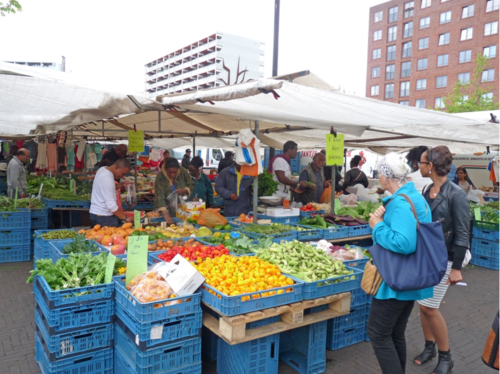Cities consist of a fusion of different cultures, each bringing their own culinary cultural heritage to the city along with a diversity of exotic vegetables and spices used in their dishes. What do all these people eat? Where are the products coming from? In many cases, these products are imported from their native regions, and unfortunately, they are not always produced in a sustainable way.
This project explores the culinary cultural heritage of different cultures to identify the chances for local and sustainable production of traditional exotic vegetables, fruit and herbs.
The food strategy of Amsterdam
Recently Deputy Mayor Laurens Ivens – responsible for Housing, Construction, and Public Space – launched the food strategy of Amsterdam. Reason for that is because he states that we live in a fattening (obesogenic) society, a society in which unhealthy food predominates. We have a food system that leads to waste, animal suffering and sometimes unnecessary transport distances. He proposes that too few actions have been taken up and implemented within the Amsterdam food strategy.
Amsterdam has a series of herb, vegetable and allotments, food forests. The Deputy Mayor indicates that in view of the continuing growth and densification of the city, a choice for urban agriculture and food initiatives is no longer a temporary one. Structural space must be created and laid down for urban agriculture.
Amsterdam Zuidoost as model for a multicultural culinary heritage
Amsterdam Zuidoost (i.e. South-East) is a district with richness of cultures. To illustrate, Zuidoost is a district with 80,000 residents from 130 different cultures; 83% of the residents have a migration background, mostly non-Western (74%). The largest groups are Surinamese Amsterdammers (33%) and Amsterdammers of "other" non-Western origin (30%, including a large group of Ghanaians) and Antillean Amsterdammers (6%).
All these nationalities have all brought their own culinary heritage to the city. As a result of its multicultural character Amsterdam Zuidoost is a hotspot where one can enjoy delicious food from the world cuisine.
Local demand for exotic vegetables and herbs
At the local markets on the Anton de Komplein Arena Poort, Ganzenhoef, Kraaiennest, Reigersbos and local supermarkets and toko's in Zuidoost, local retailers and traders offer a variety of exotic vegetables and herbs that are used in various culinary dishes. So, why do we want to explore the potential to locally produce these traditional exotic crops?
Some of these products are grown in Dutch greenhouses, but a considerable part is imported from elsewhere by ship or plane - accompanied by the necessary transport kilometers.
In addition, local retailers and traders complain about the irregular supply and the large fluctuation in purchase prices. In some periods these vegetables are scarce, and prices are high. Now that these imported vegetables become more expensive, thus, exotic vegetables are becoming an unattainable luxury, especially for residents with a limited income. Therefore, at the same time, the temptation to opt for easy (and cheaper) alternatives that the obesogenic (fattening) society seems to offer, increases.
As a result, concerns are also expressed about the quality of the vegetables (not beautiful, not fresh) and possible health and sustainability issues due to excessive use of pesticides and/or herbicides. To illustrate:
- Inhabitants of Southeast also experience more health problems than the average citizen of Amsterdam. Almost half (48%) of the adults in Southeast are overweight. 16% of them are seriously overweight, or obesity. 10-year-olds in the Bijlmer Center are also more often overweight (36% versus 23% city). This age group also sports relatively very little in a club context (47% compared to 69% in Amsterdam);
- Diseases related to unhealthy diet and lifestyle 7% of the inhabitants of Zuidoost have diabetes (diabetes) and 5% of the inhabitants of Zuidoost suffer from cardiovascular disease. (source GIB Amsterdam 2014). Worldwide, and also in the Netherlands, the number of diabetes and heart patients has increased sharply in recent years. It is known that an unhealthy lifestyle with little exercise, an unhealthy diet increases the risk of diabetes and heart failure.
That is why local retailers want more insight and control over the production chain.
All this makes it particularly interesting to test the potential of traditional exotic crops for local production in this specific area in Amsterdam.
Urban farming Gaasperplas in Zuidoost
In order to search for a form of urban agriculture that matches the culinary heritage, and desires, of the residents of Amsterdam Zuidoost, among others, a 'living lab' is being set up, where locally new cultivation systems with the top knowledge available in the Netherlands in the field of agriculture can be developed for exotic vegetables. Research questions that could be explored in this Living Lab:
Can innovations in urban agriculture and urban planning play a role in preserving cultural heritage? What are the main dishes from different cultures in this district? What ingredients do we need to cook traditional recipes? Can we create urban agriculture to grow these exotic vegetables and herbs on our own soil? Which technological innovations are needed for this?
At the same time, this Living Lab can act as a platform for growers and traders to assemble these diverse crop systems and develop viable business models and short food chains to preserve the city's culinary heritage.
